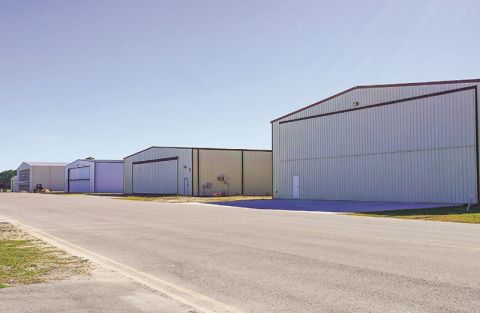Southwest Hangar Complex at Gulf Shores Int’l is Full

If Gulf Shores International Airport (JKA) were a hotel, management could hang up a “No Vacancy” sign regarding its available hangar space.
 Airport Director Justin Fletcher proudly reports that all 13 sites of JKA’s Southwest Corporate Hangar Complex are filled. Tetelestai Aviation snagged the last one when it signed a 20-year lease agreement last June.
Airport Director Justin Fletcher proudly reports that all 13 sites of JKA’s Southwest Corporate Hangar Complex are filled. Tetelestai Aviation snagged the last one when it signed a 20-year lease agreement last June.
Leasing the last parcel was an important milestone for the Alabama airport also known as Jack Edwards Field. The project as a whole was conceived early in the Great Recession of 2008. After the associated infrastructure was in place, the Gulf Shores Airport Authority didn’t get many inquiries from potential tenants for many years, and the land prepared for development sat vacant.
Then, the economic winds shifted. The Gulf Shores area experienced a boom, and businesses flocked to the area. Suddenly, sites at JKA’s “new” hangar complex become a sought-after commodity. The project envisioned in lean economic times was in place to significantly change the airport’s fortunes today, Fletcher explains.
|
Project: Southwest Corporate Hangar Complex Lease Out Location: Gulf Shores Int’l Airport (in AL) Airport Authority: Gulf Shores Airport Authority Scope: Proprietary mixed-use development with 13 corporate box hangars & 3 T hangar complexes ranging in size from 60 x 60 sq. ft. to 100 x 100 sq. ft. Footprint: 24 acres with parcels ranging from .75 -1 acre
Total Leased Space: Planning: 2008-2010 Construction: 2010-2011 First Lease: 2011 Final Lease: 2023 Sample Tenants: Gulf Air Center; Sky Warrior Flight Training; Tetelestai Aviation |
Today, the complex has nearly 129,000 square feet of hangar and office space that all sprang up in the last six or seven years.
“The Southwest Corporate Hangar Complex has been a significant improvement to the airport’s revenue budget,” says Fletcher. “It has increased the amount of based aircraft that operate here in Gulf Shores, and the amount of development interest has increased exponentially.”
Primitive Parcel to Fruitful Development
Prior to 2008, all of JKA’s leasing activity was relegated to the northwest corner of the airfield. But Russ Kilgore, airport director at the time, started coordinating with the FAA Southern Regional Airports Division to determine the next phase of development.
“They started taking a look at a parcel on the airport that was just a stand of trees,” Fletcher explains. “It was all grown up, and there was a drainage ditch that ran through it.”
Despite its primitive condition, planners selected the 24-acre tract for a new corporate hangar complex. And in 2010, the FAA Airports District Office in Jackson, MS, issued a $2.2 million grant for reconfiguring a taxiway to enable the project.
Barge Design Solutions provided project management services for the taxiway infrastructure construction, with Senior Project Manager Michael Cole leading the process from inception and the early environmental phase through design, grants administration and ultimately project management.
Cole, who also serves as JKA’s airport engineering consultant, credits the Gulf Shores Airport Authority for having the foresight to realize its vacant land had the potential to be developed into prime real estate—and for seeking outside engineering counsel to do so. The overgrown area was duly added to the airport’s capital improvement plan, and the Airport Layout Plan was adjusted to highlight the area for future development.
 Cole worked with the Jackson Airports District Office to plot the staged development. “We didn’t want to build hangars at the time,” he explains. “We just wanted to provide the infrastructure for hangars, and that included providing the taxi lanes and automobile ingress and egress.”
Cole worked with the Jackson Airports District Office to plot the staged development. “We didn’t want to build hangars at the time,” he explains. “We just wanted to provide the infrastructure for hangars, and that included providing the taxi lanes and automobile ingress and egress.”
In addition to clearing out the stand of trees, a drainage ditch that ran through the parcel was rerouted to convey stormwater more efficiently around the airport.
“We put utilities out on the site—sanitary sewer, water and power—and then we did kind of a master plan, laying out varying sizes of hangars.”
In the end, the mixed-use development included corporate box hangars and T hangars ranging in size from 60 x 60 square feet to 100 x 100 square feet, with object free area requirements for the new taxi lane based on these hangar sizes.
Hurry Up and Wait
The plans were sealed in 2010; construction started later that year and lasted about 200 days. Upon completion in 2011, however, a lingering hangover from the Great Recession of 2008 continued to thwart demand for private and corporate hangar space.
“To be honest, we finished the project and it sat vacant for some time,” Cole relates.
Fletcher also remembers the extended lull: “When the parcel was open after construction, this greenfield was ready to go for development. But at the time, the economy was recovering from the big 2008-2009 downturn.”
In due time, private individuals began inquiring about constructing their own corporate-style hangars, sized for both piston and turboprop aircraft. By late 2011, the first lease on one of the greenfield parcels was signed under Scott Fuller, airport manager at the time.
Then the leasing process picked up steam. “It initially was a dribble, but it turned into a full stream, and it has been rapid over the last two years,” Cole recalls. “There has been a lot of development and a lot of interest out there.”
After capturing the first lease signature in 2011, airport leadership worked to continue the trend. “The Authority basically took the viewpoint to make the lease process as streamlined as possible so that we would facilitate working with the city of Gulf Shores on building permits and ensuring that development on that property would move forward,” Fletcher explains.
Fast forward to today, and there are 13 new hangars on parcels between .75 acre and 1 acre. Individual hangars range in size from 8,000 to 14,000 square feet. Many were built by Ken Gates.
“As folks started building, it generated interest,” Cole says. “It is like anything else. Once something starts going, other people get interested in it. It has kind of domino effect, and it is full now.”
Fletcher relates that once Gates built the first hangar, prospects started approaching him to build more.
Future Opportunities
Now that the Southwest Corporate Hangar Complex is completely leased, JKA is preparing to open up other land for future development.
“We have no further available parcels, so our next phase of development for the next 10 to 15 years is going to be the north side of the airport,” Fletcher says.

The airport developed a primitive 24-acre parcel into nearly 129,000 square feet of hangar and office space.
During a recent Airport Layout Plan update, it was established that all future development will be focused primarily on private aviation alongside a push for adding commercial service. “We are currently building a commercial terminal as well,” Fletcher shares, adding that industrial aviation will be kept on the east side of the airport.
He explains that JKA’s Gulf Coast location near the last white sand beach before the Mississippi River is driving commercial demand, with 8.5 million people visiting the tourist destination annually.
“We have pristine beaches that are very family friendly,” he notes. “And there’s a lot of activity with condos and hotels. Our location drives demand for people wanting to be here, and Baldwin County as a whole is just growing rapidly.”
Until JKA lands a commercial carrier, tourists visiting the Gulf Shores must use Mobile Regional Airport or Pensacola International Airport, both of which are an hour from the pristine Gulf Shores beaches.
Fletcher hopes to save visitors that extra drive time.
“Fingers crossed, we will have exciting announcements to make in the near future,” he says of the project that is currently in design. “Getting commercial service here in Gulf Shores has been in demand for several years. We are in talks with multiple airlines, so this airport will continue to be an economic engine for Alabama’s Gulf Coast.”
FREE Whitepaper
Fairbanks International Airport Baggage Transport Conveyor Enhanced With Mod Drive™ System
Airports face a host of unique industry challenges, such as meeting efficiency regulations and seeking out the best maintenance practices to reduce costs and keep operations flowing. In today’s current economic climate, any potential cost savings can go a long way.
In 2019, Alaska’s Fairbanks International Airport (FAI) sought to modernize its equipment and operations. They were dissatisfied with the performance of the gearmotors on their baggage transport conveyors and began searching for new suppliers. Regal approached FAI with a solution that could improve equipment performance and simplify maintenance, with the added benefit of energy cost savings: the Hub City® MOD Drive™ system.
This white paper discusses the hardware deployed, the test results and the annualized expectations for ROI.
 facts&figures
facts&figures








